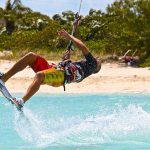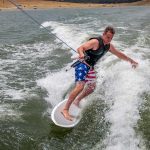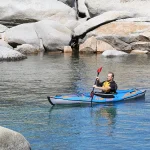If you consider yourself a skilled kiteboarder and are ready to try some new moves, Alby Rondina and Laci Kobulsky from our Sicily Kitesurf Centre have shared their 11 favourite tricks that look great but are surprisingly easy to achieve.
Tricks for advanced free riders
Double Backroll
Why not try a double backroll the next time you’re kiteboarding? In the past, kiteboarding was all about multiple spins, but now we value execution over numbers.
A well-executed, powered double rotation with the kite lower and landing at speed looks and feels great! Even better if you can add a grab and get compact while in rotation!
A good tip for improving your kiteboarding skills is to keep your kite high in the sky and always keep track of its rotations.
Difficulty: 3/5
High Jump Crail to Tail Grab
High jumps that involve grabbing the board are not only more aesthetically pleasing, but they also help the jumper to stay compact and balanced in the air.
So mix things up and add a second grab! Our tip is to make backhand grabs, as they are easier to land. Start with the harder Crail grab by placing your backhand on the nose, and then move that hand to your board’s tail.
Do the harder grab first, bending your front leg and straightening your back leg. This will bring the nose of the board close to your hand.
Difficulty: 2/5
Inverted Frontroll
Make sure you can do a front roll before trying to add a tail grab and inverted rotation. Jump a little higher than normal and use your core muscles to keep yourself stable.
If you want to get your board over you, look down at the water and activate your core muscles.
Difficulty: 2/5
Front roll Nose grab Transition
Do a front roll transition the next time you’re at the beach to impress people. It’s not as hard as it looks, especially if you grab the nose of your board to keep yourself small.
Once you’ve done this trick, you can try doing it with a kite loop or hand drag.
An PRO tip is to keep holding the grab and rotate along with your head.
Difficulty: 2/5
One Foot Transition
If you can already do a basic transition with a tail grab, you can try making things more difficult by sticking one foot off while you change directions. The hardest part is landing, but if you practice a few times, you’ll be able to do it.
If you’re finding it difficult to keep your kite flying in the power zone, try loosening your back strap. This will allow you more movement and will help keep the kite in the power zone.
Difficulty: 3/5
Backroll Kiteloop Transition
A backroll transition is a fairly easy move, but it can often lack excitement. Luckily, there is a simple solution – add a kite loop! First, start easy with a baby heliloop with the landing, but later you can progress to a huge loop in the air.
Also, looping with transitions is much easier and safer than full-speed mega loops.
If you’re just starting out with kitesurfing, it’s a good idea to begin practicing with moderate winds. You should also start by landing the kite in a loop.
Difficulty: 1/5
James Hand Drag
The hand drag is a signature move of James Boulding’s that you’ll see in any of the latest Cabrinha catalogues or product videos. It’s a great pose for shots, but it’s also a really simple trick that you can try the next time you’re out.
You’ll need a bit of stronger wind for this trick since it’s best done powered up, and you should also activate your core to shoot your legs up.
This is a good tip to follow if you want to get the most out of your kite. Try flying it at a higher altitude to get more power out of it.
Difficulty: 2/5
One Foot Slide
The one-foot slide is a difficult but rewarding trick where one leg drags in the water. This movement is similar to a darkslide and results in a unique and amazing feeling.
The key to mastering this trick is to first master the darkslide and one-foot jump, then move on to trying it with a bigger kite.
Difficulty: 4/5
Surface pass
A surface pass is a great way to start learning more advanced unhooked tricks. It’s often neglected, but it’s a great move to learn because it will help you with other, more advanced handle passes.
To do a surface pass, unhook from the kite, go downwind, and then pop up to toeside. From there, continue the rotation by passing the bar behind your back.
If you’re surface passing (traveling along the surface of the water), it’s best to go downwind to avoid any loose lines.
Difficulty: 3/5
Unhooked Tantrum
This unhooked move is one of the most impressive! It requires a lot of strength to hold the unhooked kite with one hand while spinning. If you can manage that, the trick is not too difficult – just imagine doing a backflip!
Backflipping into the water after takeoff is a great way to make a splash!
Difficulty: 4/5
Unhooked kiteloop
One of the most scar-looking unhooked tricks is the unhooked kiteloop, which is not seen that often anymore, but it was a big deal in the past. The kite looping part is during your pop and the kite springs you forward, so it is easy to make air passes. Try it first with lighter winds, just enough for a solid Raley jump.
If you’re trying to loop quickly, place your front hand under your backhand on the bar.
Difficulty: 2/5
Trick inspiration for intermediate kitesurfers
One could say that my progression in tricks has decreased over the years, and there are a few reasons for this. unfavorable freestyle conditions and fear of injuries are two factors, but a large reason is also a lack of inspiration.
It’s inspiring to watch riders who are at your level or slightly better. Seeing a rider’s repertoire of tricks, as well as their individual style and execution, is so inspiring!
We see too little of this intermediate level in online media, where the sponsored riders are always at the top level. Even if it’s awesome to watch someone do a double handle pass, it’s just too difficult to relate to as an inspiration.
I wish I saw more kiteboarders doing tricks that inspired me, but most of the people I see just want to go as high as possible. I’m not that good, but it would be nice to see more than just the basic tricks.
I figured you might be experiencing something similar. Although we’re not able to ride together, my hope is that this list of tricks, as well as my own progression from beginner to experienced kiteboarder, will encourage you to try something new the next time you go out.
Trick progression – The early days
As a beginner kitesurfer, my first tricks were the back roll, front roll, and sent jumps. Adding height, consistency, and variations to those tricks kept me busy for some time, and I’m still expanding and improving on them.
- The back roll is super simple to do, with barely any lift needed at all. Try some of these variations:
- Add a tail, indy or Crail grab
- Back roll transition
- Hand drag transition: Lean into your harness, lift your legs and dip your hand in the water
- Go double (or triple!) – Two spins are all I can do. You need more height and initiate the first rotation quite aggressively, and don’t stop looking over your shoulder or you’ll end up on your back.
- The front roll took longer to master but is now my go-to trick and it’s much easier to do a controlled front roll since you spot the landing much sooner than with a back roll. Try these to mix it up:
- Invert it! Front roll invert is easier than back roll invert – Simply throw your legs up and try to look at the sea. This is normally combined with a boned-out tail grab, but Tom Court does a cool backflip variant.
- Double front roll, Same idea as for the back roll. Add grabs for more style.
- Crail grabs the front roll. I got into this recently. It’s fun and a bit weird because you spin in one direction but turn your shoulders in the other, which slows down the rotation a lot.
- Front roll transition – You need a bit more height with this transition and you won’t spot the landing which makes it harder.
I was soon interested in doing the type of kiteboarding that the guys I saw were doing. I got a board with boots that was specifically for doing tricks that involve being pulled behind a boat.
Even though I liked the feeling of being secure on the board, this style choice was more for show.
Unhooked freestyle tricks
Some people never unhook their kites because the learning curve is too steep to be worth it for the average person. To do something even slightly stylish, you need a lot of practice and commitment.
I kiteboard because I think it looks cool and it is similar to wakeboarding. I want to learn more difficult tricks.
I find it difficult to unhook in choppy water or with strong winds, so I only try to do so when the conditions are ideal. This usually means gentle waves and light wind. Unfortunately, these conditions are rare on the UK’s south coast.
I rode flat water spots a lot in the early years, but I never managed to do an aerial handle pass. I sort of gave up on progressing in freestyle, but if the right conditions are there I still try to do a Railey to the blind.
Surface tricks
- Surface tricks are all about style. They’re small and playful board manipulations that you can do in isolation or add before or after an aerial trick. They’re good fun to practise because there’s not a lot of force involved if you crash but they can be quite technical so they offer up a good challenge.
Check out Jake Kelsick’s videos for surface trick inspiration – smooth as butter.
- Riding blind. Easy to practise without fins, but much easier with fins once you’re in the right riding position.
- Blind to toeside transition – Dirt easy, just bring the kite across the window and ride away.
- Butter slide/nose press – Really simple to do on flat water if you’re properly powered up, but fins make it much harder. Add a hand drag for extra style (can also be done as a tail press, riding backwards but this is harder).
- 360 pop to the blind (hooked in) – Start toeside, go downwind, pop and spin around to the blind. I normally do this off a small wave kicker close to shore.
- Hand drag – On a well-powered day, this trick is easy. You just need to work out the timing between the lift in the kite and inverting your body while dipping your backhand in the water.
Try landing blind once you’ve mastered normal hand drag.
- Surface pass (unhooked) – A handle pass while going downwind. I find it easier to do a backside rotation (blind instead of wrapped), but it’s a preference.
- Pop to the blind – If you can do a surface pass, the next evolution is to pop into the rotation.
Powered hooked in tricks
- For the powered tricks you load and pop using the board while keeping the kite low, just as with an unhooked new school trick. I often do these using a wave as a kicker to gain extra height.
You know you have a good pop when you land with slack in your lines (but this also depends on your kite).
- I’m still no master when it comes to powered tricks, but it’s a nice hybrid between hooked in and freestyle as you keep your kite low and your tricks are horizontal and powerful. The key to all these tricks is good pop and don’t let the kite swing back on top of you.
Hands in the middle of the bar and keep a bit of pressure on the front hand. Try and get as inverted and elongated as possible for more style.
- Back roll and front roll – I don’t do these much. They look and feel a bit lame, especially the back roll. Front with a grab can be quite neat.
- Much better to add another 180 and do a back2toe or front2blind. You can even do a hooked-in back2blind.
- Crail (aka Holy Grail, aka Holy Crail! – Backhand grabs the nose while tweaking out the back leg and go inverted. Hands down one of the most stylish tricks in the line-up. Pretty damn hard to get your body in position though.
I’ve tried it for years now and still can’t do it. Some call it Nuke or Nuclear which is grabbing the heelside instead of the nose.
- Seatbelt – similar but opposite. The front hand grabs the tail.
- Indy glide – Like the Crail but grab indy, between your feet.
- Backside air – Snowboard classic. Pop like a Railey and grab the heelside of your board with your front hand.



